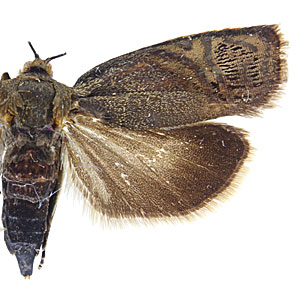Overview

Cydia is a worldwide genus that contains approximately 200 described species. Adults are small to medium sized and many species are gray brown with a distinct ocellus. The genus is characterized by a thickened anal fold in the male hindwing that contains a hair pencil and modified sex scales (Horak 2006). Male genitalia are characterized by the absence of an uncus and socii and constriction of the valval neck. Females usually have two signa in the corpus bursae.
Cydia larvae are borers in the fruit, nuts, cones, and pods of mainly Fabaceae, Fagaceae, Pinaceae, and Rosaceae. Larvae are whitish to reddish and resemble those of other internal-feeding olethreutines. Grapholita larvae are similar in appearance but the two genera can usually be separated by the anal comb, which is present in many Grapholita and absent in most Cydia. For more information on Cydia larvae, please consult the fact sheet and keys on LepIntercept - An identification resource for intercepted Lepidoptera larvae.
This genus contains many pest species, such as Cydia pomonella, which is the most widely distributed and important pest of apple, pear, and walnuts in the world. Cydia larvae are the most commonly intercepted tortricid larvae at U.S. ports of entry, and the species treated here cover the most commonly intercepted taxa, which arrive primarily from Asia, Europe, and South America. For photos of additional non-targets not covered here, visit the Moth Photographers Group link below.
Target species
Cydia araucariae
Cydia coniferana
Cydia deshaisiana
Cydia fabivora
Cydia fagiglandana
Cydia glandicolana
Cydia kurokoi
Cydia pomonella
Cydia splendana
Cydia strobilella
Non-target species
Cydia caryana
Cydia garacana
Cydia latiferreana
Cydia toreuta
Links

The following external links require an internet connection. The authors, CSU, CDFA, and USDA/APHIS/PPQ/CPHST are not responsible for the availability or content of these external sites:
Moth Photographers Group - Grapholitini
References

Bradley, J. D., W. G. Tremewan and A. Smith. 1979. British Tortricoid Moths - Tortricidae: Olethreutinae. The Ray Society, London, England. 336 pp.
Brown, J. W. and Komai, F. 2008. Key to larvae of Castanea-feeding Olethreutinae frequently intercepted at U.S. ports-of-entry (Lepidoptera : Tortricidae). Tropical Lepidoptera Research. 18(1): 2-4.
Gilligan, T. M., D. J. Wright and L. D. Gibson. 2008. Olethreutine moths of the midwestern United States, an identification guide. Ohio Biological Survey, Columbus, Ohio. 334 pp.
Horak, M. 2006. Olethreutine moths of Australia (Lepidoptera: Tortricidae). Monographs on Australian Lepidoptera, Vol. 10. 522 pp.
Razowski, J. 2003. Tortricidae of Europe, Vol. 2, Olethreutinae. Frantisek Slamka, Slovakia. 301 pp.
Photo Credits

Figs. 9, 11: Whitney Cranshaw, Colorado State University, Bugwood.org
Fig. 10: Gyorgy Csoka, Hungary Forest Research Institute, Bugwood.org
Fig. 12: Gyorgy Csoka, Hungary Forest Research Institute, Bugwood.org

